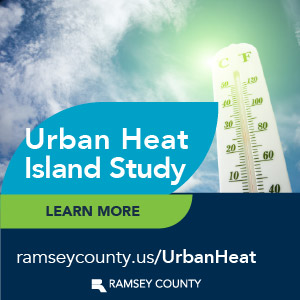Ramsey County services are not impacted by the Federal shutdown at this time.
New urban heat island data pinpoints hottest spots in metro area

The past 10 years were the world’s hottest years, with 2024 being the hottest year ever recorded. As our climate continues to change, Ramsey and Hennepin counties experience more and more extreme weather. To better protect residents, the counties conducted a joint urban heat island study, supported by a National Oceanic and Atmospheric Administration grant and facilitated by an outside consultant, CAPA Strategies.
The data collected was analyzed to map where the hottest parts of the Twin Cities communities are.
Some key observations:
- Highly developed urban areas, such as downtown Minneapolis and downtown St. Paul, have higher temperatures than other areas through the day and evening.
- Areas with fewer homes where land is used for airports and other industrial structures drive temperatures higher. These pockets of higher temperatures can affect nearby residential areas.
- Street trees, green space and water, help to alleviate heat in residential areas. For example, neighborhoods near Lake Harriet in Minneapolis and Vadnais Lake in Vadnais Heights are cooler than areas without shade, green space or water.
Hennepin and Ramsey counties were chosen to participate in the National Oceanic and Atmospheric Administration’s Urban Heat Island Mapping Campaign to map the hottest neighborhoods in 14 U.S. communities and four international cities. Using heat sensors mounted on their cars, volunteer community scientists traversed designated routes in the morning, afternoon and evening on one of the hottest days of the year. The sensors recorded temperature, air quality, humidity, time and location.
The study was conducted July 27, 2024 – one of the hottest days of the summer – with the help of community volunteers. The volunteers put sensors on their cars and traveled designated routes in the morning, afternoon, and evening. The devices gathered temperature, humidity, time, and location data. (Images and video of this research and the equipment used to collect data is available upon request.)
Ramsey County also gathered air quality data.
Findings from the study are now posted online. The counties will use this data to guide decision-making and planning to help residents cope with extreme heat and other extreme weather—With particular focus on helping decrease heat in the hottest neighborhoods.
In Ramsey County, this information will help guide the development of strategies to reduce the health impacts of extreme heat for people living in the hottest areas of our community and the development of an air quality monitoring network. The urban heat island study is one of the most recent projects the county is doing as part of the Climate Equity Action Plan.
Hennepin County will use the data and maps to inform its strategies for combating and helping residents cope with extreme heat. These include helping residents protect their health, offering cooling spaces and finding ways to reduce the temperature in urban heat islands (for instance, by providing more tree canopies or reducing the amount of paved area).